The Varna system divides the society into four sections ; Brahmin, Kshatriya, Vaishya and Shudra. the caste system was an embodiment of the principle of inequality. Leaders like Jyotiba Phule, Ranade, Periyar have protested against brahminical dominance for long. Due to the exceeding precedence given to brahmans by British gave rise to anti-brahmanical movements in India. these involved Kurmi Caste Association (1890) and Ahir Yadav Mahasabha(1919).
During the poat independence era, leaders believed that caste and relegion would lose their importance. Jawaharlal Nehru in his Discovery of India wrote " you can't build anything om the foundation of caste, anything you intend to build on the foundation of it, will crack and will never be a whole". Despite being outlawed, Caste as expected didn't disappear.
OBCs AND DALITS IN POLITICS
Challenge to upper caste elite Politics emerged as soon as in 1960' and 70s and more importantly in 1980 with the famous Mandal commission. A number of factors led to the rise of lower caste politics in india including abolition of landlordism, land reforms, adoption of agricultural strategies (green revolution) , incorporation of article 15(4) and leaders like Jyotiba Phule and Ambedkar in starting consciousness-raising movements. A number of parties emerged during this time, Janta Dal, Bharatiya Kranti Dal, Bharatiya Lok Dal.
an important development during this time was the demand for reservations in civil services by the Mandal Commission in 1980. Around UP and Bihar we also witnessed the Yadavization of Politics as much of the Administration was handled by yadavs.
In north India, Kanshi Ram played a major role in Dalit Politics by starting organization like BAMCEF, Dalit Shoshit Samaj Sangarsh Samiti (DS4) and BSP. In Maharashtra the movement took form of the Dalit Panthers inspired by Marxism. These institutions reflected the ideology we know as Manuwadi. a new chapter in Indian politics emerged when a dalit women was chosen the chief minister of UP, Mayawati.
Jaffrelot defined this rise of lower castes in Politics as the 'silent revolution'.It was a silent transfer of power, without violence. The rise was uneven as states like Bihar and UP saw the major change where as states like Rajasthan witnessed minimal change.
Today, Feminists are of the opinion that despite facing gender based inequalities upper-caste women still posses material resources. While Dalit men and women are the most vulnerable, Dalit women face dual discrimination based on gender and caste subjected to exploitation including sexual exploitation at the hands of upper caste men. Caste in politics has evolved with some changes and will continue to do so with the current Indian scenario







